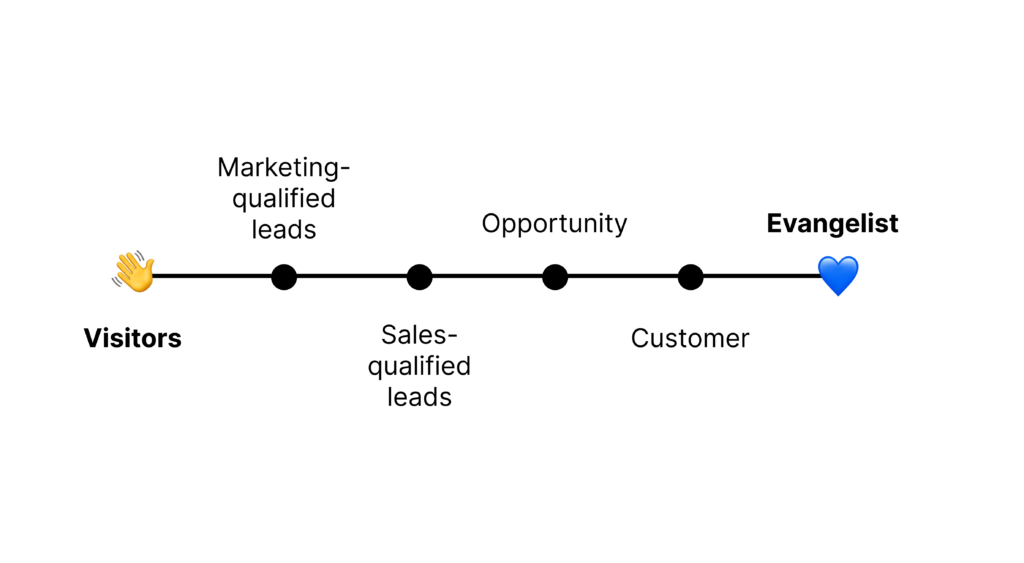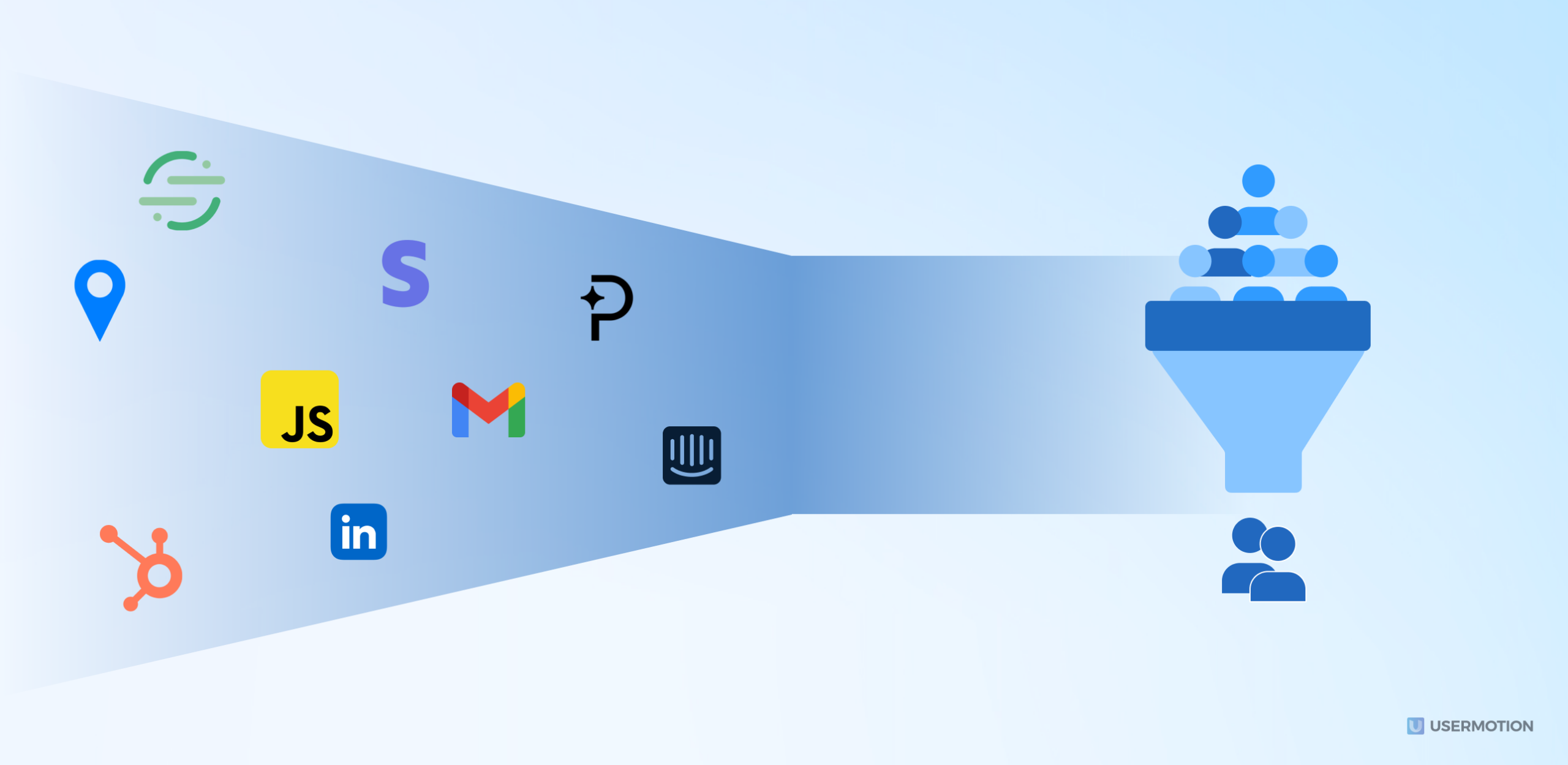In sales, focus on quality over quantity. A sales qualified lead represents a high quality prospect is your pipeline, increasing the chance of more successful conversions.
What is a sales qualified lead (SQL)?
A sales qualified lead (SQL) is a prospect that shows a strong likelihood of becoming a customer. Unlike other leads, an SQL has expressed clear interest and meets specific criteria, typically including:
- Need: They have a genuine need for your product or service.
- Interest: They’ve shown active interest in what you offer.
- Budget: They have the financial capability to make a purchase.
- Authority: They have the decision-making power.
- Timing: Their purchase timeline aligns with your sales cycle.
SQLs are highly valuable because they are the most likely to convert into paying customers, making them a top priority for sales teams.
Sales qualified lead (SQL) vs marketing qualified lead (MQL)
The key difference between a marketing qualified lead (MQL) and a sales qualified lead (SQL) is their stage in the sales funnel:
| MQL | SQL | |
|---|---|---|
| Stage in Sales Process | Intermediate stage, after initial engagement but before direct sales engagement. | Advanced stage, ready for direct sales engagement. |
| Sales Approach | Not yet prepared for personalized engagement from the sales team. | Primed for a direct, personalized sales approach. |
| Example | A lead that has downloaded a white paper or subscribed to a newsletter. | A lead that has requested a demo or a sales call. |
- MQLs are still in the early stages. They’re aware of your product but haven’t yet shown intent to buy. They might download a whitepaper or subscribe to a newsletter, indicating interest but not readiness.
- SQLs are further along in the funnel. They’ve engaged more deeply—like requesting a demo or asking about pricing—and are ready for a sales discussion.
While MQLs are important for nurturing, SQLs are the leads you want to prioritize for immediate sales outreach.
How to qualify SQLs?
Transforming a potential customer (visitor) into an SQL involves several stages:
- Information Qualified Lead (IQL): The prospect shows initial interest.
- Marketing Qualified Lead (MQL): The prospect engages with your marketing efforts.
- Sales Qualified Lead (SQL): The prospect is ready for direct sales engagement.

Assess a prospect’s suitability as a sales qualified lead (SQL) by analyzing whether they fit the ideal customer profile.
It also involves evaluating their actions to determine if they intend to purchase, according to the sales team’s criteria.
Leads typically become sales qualified leads (SQLs) when they show enough interest and intent to buy. This usually happens when they’re at the decision stage of the sales funnel.
1. Engage with your leads directly
Engage directly with leads to assess their needs and readiness. Questions you might ask include:
- Are you looking to purchase [product] soon?
- What are your current challenges?
- Can I answer any questions about our pricing?
- Who decides if you will purchase [product]?
Direct communication helps you understand the lead’s needs and tailor your approach, increasing the likelihood of conversion.
2. Identify intent signals
The sales team can identify if a potential customer is ready to buy by observing their actions and behavior.
They also listen for verbal clues and use data from past sales. Additionally, they watch for common buying signals.
Common buying signals include asking good questions, talking about budget, and being willing to talk.
Signals that indicate a lead’s readiness to make a purchase include:
- Active engagement with content related to a specific feature, product, or use case: This shows that the lead has a specific interest in what your company offers and is actively researching or exploring these areas.
- Frequent website visits: Regular visits indicate a sustained interest in your company and its offerings. It suggests that the lead is in the consideration stage and is actively seeking out more information.
- High email open rates: If a lead consistently opens your emails, it’s a strong sign of their interest and engagement. It also suggests that your email content is resonating with them.
- Regular interactions with sales representatives: Direct communication with your sales team is a very strong signal of a lead’s readiness to purchase. It shows that they’re interested enough to initiate or maintain a dialogue, and are likely in the decision-making stage of the buying process.
Moving a lead from MQL → SQL
Transitioning a lead from MQL to SQL is a critical milestone. This process typically involves:
- Defining the ideal customer profile
- Identifying touchpoints in the sales funnel
- Aligning sales and marketing goals
- Determining lead scoring thresholds
- Establishing threshold points and lead score rules
- Identifying other significant actions worthy of scoring and determining point decay.
How to nurture sales qualified leads?
Once a lead becomes an SQL, the next step is to nurture them towards a purchase.
- Personalized Communication: Tailor your messages to address the lead’s specific needs.
- Targeted Content: Provide content that answers their questions and alleviates concerns.
- Timely Follow-Ups: Engage with SQLs promptly to keep their interest high.
1. Create lead magnets
Crafting compelling lead magnets is an effective sales strategy used to attract more SQLs. Providing lead magnets has an advantage. They can attract leads more likely to convert. This is especially true when they include bonuses or exclusive content downloads. It’s like using a powerful magnet that attracts only the most valuable metal pieces.
When a lead downloads an ebook or whitepaper, it shows genuine interest in the product. It suggests they are probably intensifying their research, so they may qualify as SQLs. It’s like a customer who not only browses through the store but also tries on clothes, indicating a higher likelihood of making a purchase.
An appealing lead magnet should include actionable tips, valuable knowledge, or a discounted offer. It should possess relevance and substantial value. This is usually shown through ebooks, guides, discounts, webinars, or free resources. It’s like offering a free sample that not only pleases the paying customer but also entices them to buy more.
2. Optimize your pricing page for clarity
A well-optimized pricing page can significantly boost your SQL conversions. Recommended strategies for enhancing the clarity and conversion of a pricing page include:
- Using simple and straightforward language
- Limiting the number of pricing options
- Reducing clutter and distractions
- Highlighting the most popular or recommended plan
- Using clear and engaging visuals
- Providing additional information about each plan
- Displaying social proof and testimonials
- Offering a money-back guarantee or free trial
It’s like creating a clear and appealing menu that not only displays all the dishes but also entices the customer to order.
Price clarity has a positive effect on conversion rates. Ensuring clear pricing information on product pages can result in a 34% increase in conversions. Reducing visitor anxiety can also help. Additionally, providing low-priced items can lead to heightened demand and higher conversion rates. It’s like pricing a product right; the price should not only cover the costs but also attract customers.
An effective display of value propositions on a pricing page involves:
- Ensuring clarity and conciseness
- Emphasizing the benefits
- Utilizing visuals to enhance attractiveness
- Positioning it prominently on the page, preferably above the fold
- Consistently testing and refining based on customer feedback and data
It’s like creating an attractive advertisement that not only catches the eye but also convinces the customer of the product’s value.
3. Implement targeted follow-up strategies
Targeted follow-up strategies are a powerful tool to engage with leads and move them closer to a purchase and decision making process. Personalized communication enhances targeted follow-up strategies by elevating customer engagement, refining communication with customers, and augmenting the likelihood of them engaging in business with you. It’s like a personal trainer. The trainer provides the exercise regimen. They also motivate and guide the individual throughout their fitness journey.
Several real-world scenarios have seen successful targeted follow-up strategies. They include using personalized follow-up emails and emphasizing value and trust with prospects. It’s like a teacher who not only provides the lesson but also gives personalized feedback and encouragement to each student.
Automation tools play a crucial role in implementing targeted follow-up strategies. They allow you to efficiently create custom automations. You can use them for tracking, targeting, and analyzing leads. These tools automate lead follow-up campaigns across voice and SMS. They assist in personalized outreach and follow-up for high-value accounts.
Benefits of using automation tools include:
- Simplifying the task of lead follow-up
- Enhancing the efficiency and effectiveness of the process
- Providing advanced software capabilities for tracking and analyzing leads
Businesses can use automation tools to streamline lead follow-up. This can improve their overall sales and marketing efforts.
7 examples of sales qualified leads
- The Repeat Visitor: This lead frequently visits your website, particularly product or pricing pages, indicating a strong interest in your offerings.
- The Content Engager: This lead actively downloads or engages with your content, such as eBooks, whitepapers, or webinars, showing that they are keen to learn more about your product or service.
- The Direct Inquirer: This lead reaches out directly to your sales or customer service team with specific questions about your products or services, indicating a readiness to buy.
- The Free Trial User: This lead signs up for a free trial of your product or service, showing a willingness to test out your offerings before making a purchase decision.
- The Newsletter Subscriber: This lead subscribes to your newsletters, indicating a sustained interest in staying updated about your company and its offerings.
- The Event Attendee: This lead attends your webinars or in-person events, indicating a keen interest in the knowledge you provide and a potential readiness to make a purchase.
- The Social Media Engager: This lead frequently likes, shares, or comments on your social media posts, indicating a strong interest in your brand and its offerings.
Final thoughts
Focusing on Sales Qualified Leads is essential for driving sales success. By understanding what qualifies a lead as an SQL and using effective strategies to nurture them, you can significantly increase your conversion rates and drive business growth.





